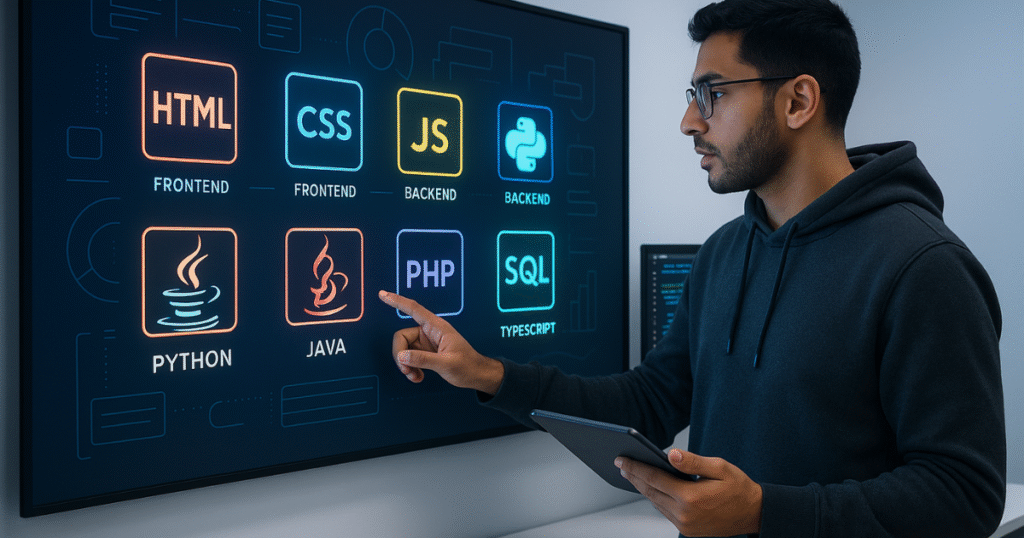Exclusive digital marketing services, 100% Satisfaction, and Money Back Guarantee! Learn More
In today’s dynamic software industry, the top programming languages you need to learn for full-stack development are key to building versatile, scalable, and high-performing applications. A full-stack developer is skilled in both frontend and backend development, allowing them to contribute across the entire software lifecycle. Whether you’re aiming for a career in web development or simply want to gain versatility in coding, this guide will walk you through the essential languages every aspiring full-stack developer should know.
Understanding the Roles: Frontend vs Backend Languages
Understanding the distinction between frontend vs backend languages is the first step in becoming a full-stack developer. Frontend languages like HTML, CSS, and JavaScript manage how users interact with a website or app. These are responsible for layout, visuals, and client-side behavior. Backend languages, on the other hand, deal with data processing, server logic, and authentication.
The key difference lies in server-side vs client-side scripting. Client-side code runs in the user’s browser, while server-side code runs on the server and interacts with databases. Full-stack developers are fluent in both, allowing them to bridge the gap between user experience and system architecture seamlessly.
Key Factors in Choosing a Full-Stack Language
Choosing the right programming language involves looking at more than just syntax. Cross-platform programming languages allow your applications to run on multiple devices and operating systems, improving your efficiency and reach. Community support, ease of learning, scalability, and integration with tools are all critical factors.
Understanding a full-stack developer’s tech stack is also essential. A modern stack often combines a powerful frontend library, a flexible backend framework, and a robust database system. The language you choose should work well within such ecosystems and offer long-term viability in the job market.
List of Top 5 Programming Languages
Let’s explore the top 5 programming languages you need to learn for full-stack development, along with the ecosystems and tools that make them so effective.
1. JavaScript
JavaScript is the backbone of full-stack development. It powers the browser and, with Node.js, the server as well. With the rise of the best JavaScript frameworks for full-stack, like React, Vue.js, Express.js, and Node.js, JavaScript has become the go-to language for building scalable web apps. Its asynchronous nature and vast ecosystem make it perfect for both frontend and backend projects.
2. Python
Python is widely loved for its readability and vast library support. It’s ideal for rapid prototyping and is often used in backend development through frameworks like Django and Flask. Python also excels in areas like automation, data analysis, and machine learning integration, making it a versatile language in any full-stack developer’s toolkit.
3. Java
Java remains a dominant force in large-scale backend systems. Known for its robustness and scalability, it powers enterprise applications and Android development. Frameworks like Spring Boot streamline the process of building RESTful APIs and microservices. Java’s strong typing and performance make it a reliable choice for cross-platform development.
4. TypeScript
TypeScript is a superset of JavaScript that introduces static typing. As full-stack applications grow, TypeScript offers better tooling, compile-time error checking, and a more maintainable codebase. It’s gaining popularity in full-stack environments where clean architecture and code scalability matter, especially when paired with Angular, NestJS, or React.
5. SQL & NoSQL (Bonus)
No full-stack journey is complete without database fluency. Knowing SQL & NoSQL enables full-stack developers to perform data modeling, write optimized queries, and handle application state. SQL (MySQL, PostgreSQL) is great for relational data, while NoSQL databases like MongoDB are perfect for flexible, document-based structures.
Popular Language Combinations for Full-Stack Developers
Many successful full-stack projects rely on proven pairings of frontend and backend languages. Some popular languages for full-stack developers include the MERN stack (MongoDB, Express.js, React, Node.js) and the MEAN stack (Angular instead of React). Python with React is also a rising combination due to Python’s backend efficiency and React’s frontend power.
Each stack excels in different areas. JavaScript dominates backend programming for web apps when combined with Node.js, while Java or Python-based stacks are favored in enterprise and data-heavy environments. Knowing these combinations can help you build fast, secure, and scalable applications.
Building the Right Skill Set: A Learning Roadmap
Becoming a full-stack developer takes more than language fluency, it requires mastering the essential skills for full-stack engineers. These include version control (Git), debugging, system design, and understanding how software components interact.
Your learning roadmap for full-stack development should start with HTML/CSS, then move to JavaScript, a backend language, databases, and finally deployment. Don’t overlook soft skills like architectural thinking, collaboration, and continuous learning, they’re just as important in real-world development.
Conclusion
Mastering the top programming languages gives you the power to build full applications from the ground up. Whether you start with JavaScript or Python, what matters most is building real-world projects and continuously improving. Combine your frontend and backend knowledge to gain true versatility in coding and launch a strong career in web development.
